Our Heritage
We’re proud of our history as Vancouver’s premier fine carpet retailer. Since our inception in 1948 we’ve worked hard to make East India Carpets the best in the field.
Trusted, experienced and reputable, East India Carpets is the first choice of homeowners and Vancouver’s top interior designers. We import affordable handmade carpets from the world’s finest weaving centers to our Vancouver showroom. From there these rugs go on to enhance the finest homes and businesses in the area.
East India Carpets founder Jab Sidhoo set our high standards of quality and service back in 1948. Today, his children, and the staff at EIC are proud to continue this tradition.
1948: East India Traders founded by Jab Sidhoo and serves as a wholesale carpet importer.
1963: Showroom is expanded to 2500 square feet and opens direct to customers.
1985: East India Carpets is Vancouver's number one importer of carpets from The Orient: Iran, Turkey, India, Tibet, China, Romania and Afghanistan.
1998: East India Carpet celebrates its jubilee year - a point of pride for Jab.
2001: East India Carpets introduces Frank Lloyd Wright Collection. To mark this acquisition, we introduce an Art Deco inspired logo type.
2010: East India Carpets now offers a curated and paired back selection of carpets. The Sidhoo Family brings other Designer Retail businesses to The Armoury District.
2022: East India Carpets launches its first e-Commerce website. The Social Media Logo is born.
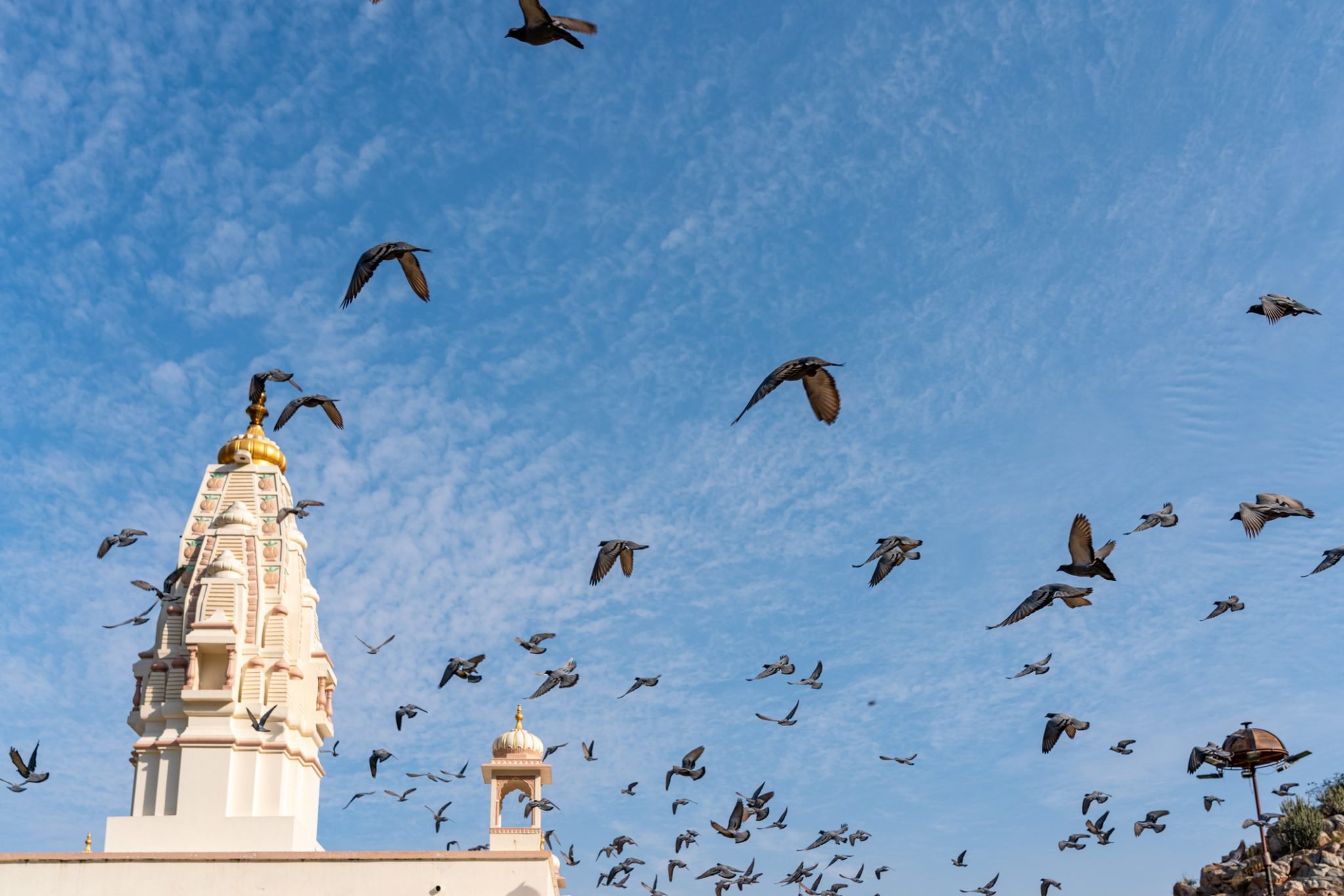
The Jab Sidhoo Foundation
Proudly Contributing to Jab’s Favourite Causes:
The Kid’s Help Line | Vancouver General Hospital | St. Paul’s Hospital
Vancouver Writers Festival | India Summer Festival
Suitcase of Memories
From rural India to aircraft mechanic and co-founder of the B.C. Lions: The amazing life of Jab Sidhoo
He was born on Jan. 8, 1923 in the Punjab in India, when it was still ruled by Britain. In the 1920s there were protests in India against high British taxes on farmland, which led to his family moving to Canada.
“My grandfather got in trouble,” explains Jab’s son, Ravi Sidhoo. “They hung him upside down because he was protesting this royalty or tax. The elders said ‘You know what? He’s a little hot-headed, they’ve got their eye on him, you’d better get him out of the country.’” The family moved to Sooke on Vancouver Island when Jab was six, and then to Kitsilano, where many members of the Indian community worked at a nearby lumberyard on Granville Island. Sidhoo went to Kitsilano High School in 1939 but transferred to Van Tech by 1941, hoping to learn a trade.
The turning point in his life was when an air force recruiter came to Van Tech during the Second World War, looking for young guys who wanted to learn aircraft maintenance in Saskatchewan. “Jab puts up his hand, and some other kids put up their hand. (But) the recruiter only takes the Caucasian kids,” said Ravi. “The teacher stands up and says ‘If you don’t take Jab, you don’t take the other two kids.’”
Sidhoo became an aircraft mechanic in Caron, Sask., and also spent time in Whitehorse. Away from the Indian community, he had to socialize and talk to people “outside his comfort zone,” which would later help him in business.
“When you’re an immigrant like that, there’s no community centre (to meet people),” explains Ravi. “You don’t feel that comfortable to go down and play a pickup basketball game (like today). That decision by whoever that teacher was in Tech, that changed his life.”
After the war Sidhoo founded East India Carpets as a wholesaler in 1948. In 1962 he opened a retail outlet at 1606 West 2nd, where it’s still located.
Sidhoo was proud that he was asked to provide the Persian carpets for all the royal visits to B.C. But he was also a supporter of Indian independence: Inside a suitcase of his father’s personal effects, Ravi found a photo of a striking woman labelled “Vijay Lakshmi Pandit, National Committee for India’s Freedom.” Pandit was the sister of Jawaharlal Nehru — the first Prime Minister of India after it became independent in 1947 — and a political force in her own right, serving as a governor, cabinet minister and diplomat.
The suitcase contained some marvellous items, including photos of Jab as a kid and a colourful certificate Pan-Am Airways handed to passengers who crossed the international dateline aboard its famous Flying Clipper plane in the 1940s. There are also mint copies of the Kitsilano and Van Tech yearbooks from 1939 and 1941, complete with autographs from some of his classmates.
His son smiled. “He was on the rugby team in Kits,” said Ravi. “He goes over to Tech, and they played in the finals. Even in his last year, he was so pissed that Kits beat them by one point. It killed him, because those were all his buddies that he’s playing against.”
For more images visit vancouversun.com

An undated photo of Jab Sidhoo walking down Granville street in Vancouver by street photographer Foncie Pulice

A certificate given to Jab Sidhoo after he crossed the International Dateline on the famous Flying Clipper airplane is part of his collection

An undated photo of Jab Sidhoo as a child growing up in Sooke

An undated photo of Jab Sidhoo at the Caron Airport Cafe in Saskatchewan
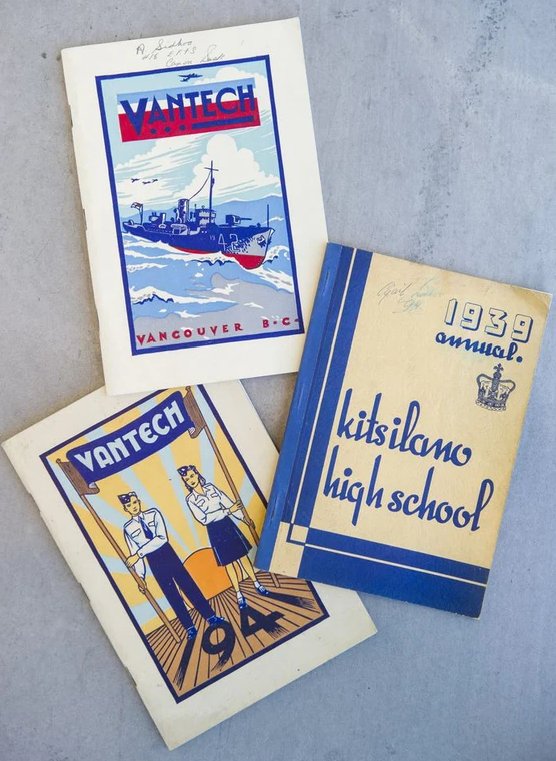
Jab Sidhoo’s high school yearbooks from Van Tech (1941 and ’42) and Kitsilano (1939)
Jab & The B.C. Lions
Jab Sidhoo loved football.
He was one of the founders of the B.C. Lions back in 1953, when it was a community organization, and remained a Lions season ticket holder until he passed away on Feb. 22 at the age of 93.
As the owner of East India Carpets in Kitsilano, he produced a special rug for the Lions boardroom with the team logo, a lion roaring with its paw on a football. He was so into the team that in the ’60s he used to take his young son around to meet many of the players.
“Willie Fleming had a clothing store,” recalls Ravi Sidhoo. “It’d be like Drake selling clothes (today). My dad took me in as a kid. I was too small to wear anything — I’m eight years old, I couldn’t wear a men’s suit.
“But he had like the hippest clothes, and so all the players would go there, like Bill Munsey and all the black guys would go. Willie couldn’t find any good clothes (in Vancouver), so he had hats, the best.”
Over the years Sidhoo accumulated a lot of football ephemera, such as old Lions programs, vintage copies of the Canadian Football News weekly, even a run of rare Touchdown magazines from the early ’60s.
His son has decided to donate them to the B.C. Sports Hall of Fame. But before he did, he let the Sun and Province scan them.
For CFL fans, this stuff is gold.
The Aug. 31, 1961 Touchdown features a photo of quarterback Joe Kapp, just after he was traded to B.C. from Calgary. Kapp is wearing a helmet without a faceguard, which is somewhat odd given that faceguards were introduced in the mid-1950s.
There are two stories on the Kapp trade, one of them by longtime Vancouver Sun columnist Denny Boyd, who relates how Vancouver fans were split on the trade because the Lions gave up four players for Kapp.
They probably changed their tune when Kapp led the Lions to the Grey Cup game in 1963 and ’64.
Touchdown was produced in Vancouver by William R. Good, popularly known as Bill Good Sr. The associate editor was another legendary Sun columnist, Jim Kearney.
The covers of the Touchdowns are classic, often featuring black and white action shots of stars like Jackie Parker, Bernie Faloney or George Dixon. The magazine seems to have been printed between 1961 and 1964.
For many Lions fans the key items in the collection are a quartet of old programs, three from Empire Stadium (in 1957, ’58 and ’66) and one from Clarke Stadium in Edmonton (in 1962).
The cover of the Oct. 6, 1958 program features Miss B.C. Lions 1958, Sharon Durham, high-stepping in a Lions cheerleader’s outfit. Inside is a small feature on the 19-year-old, who was studying bacteriology and zoology at the University of B.C. Oh, and she was 5 feet 6½ inches, weighed 130 pounds and had blue eyes and brown hair.
The cover of an Eskimos-Lions program for a game in Edmonton on Aug. 31, 1962 shows the hometown bias. An angry cartoon Eskimo is pictured carrying a block of ice to trap a lion in an igloo.
Some of the ads are hilarious. A 1966 ad for CKWX shows its sports team posed in Lions jerseys numbered 11 and 30, to match the station numbers. One of the photos is of longtime Canucks announcer Jim Robson, who’s holding a football in his right hand and is straight-arming with his left, a standard pose of the day.
A Cablevision ad from the same program shows how many stations you could get with the new service – seven. Each channel number is featured on a drawing of a player, and together they’re lined up like an offensive line.
“The season’s big touchdown play: colour reception — complete in your living room,” says the ad. “Convert now! The name of the game is entertainment — and you have never had signals like this before!” It was a different time. The referee signals in the 1966 program were co-sponsored by Wally’s Burgers and Panasonic.
Could you imagine a multi-national teaming up with a small local business like that today?

1969 Touchdown Magazine (Produced in Vancouver)
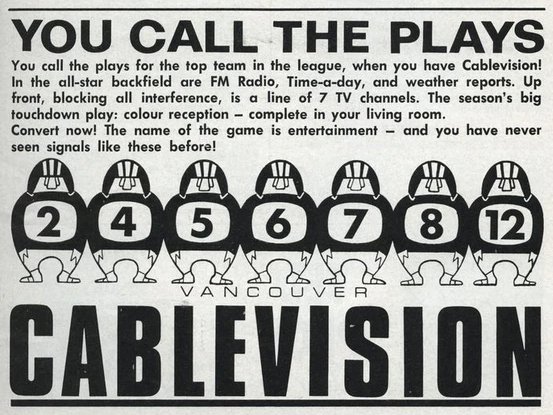
Sept. 10, 1966. Cablevision ad from a BC Lions program

Sept. 10, 1966. Referee signals rom a B.C. Lions program, sponsored by Panasonic and Wally’s Burgers
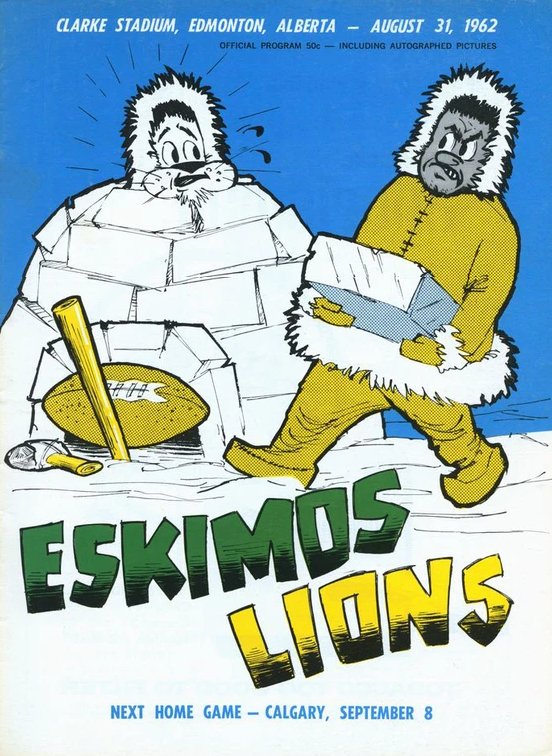
Cover of a program for a 1962 CFL football game between the B.C. Lions and Edmonton Eskimos at Clarke Stadium in Edmonton

Sept. 16, 1957. Begg Motors ad from a B.C. Lions program for a game against the Winnipeg Blue Bombers
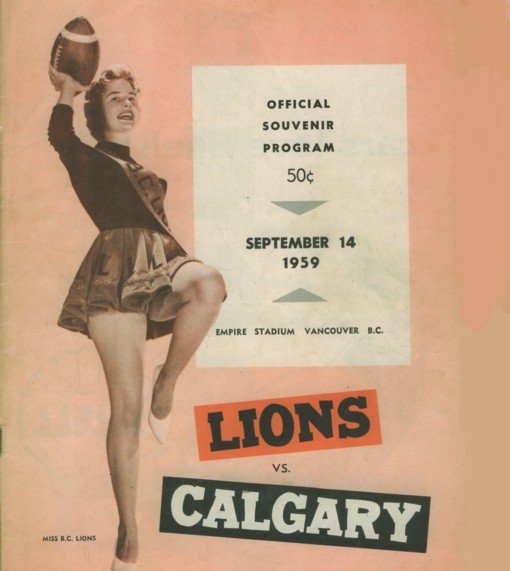
Miss B.C. Lions on a 1959 Souvenir Program

Lions @ Bombers, 1965

Cartoon Program from 1959

Canadian Pro Football Illustrated magazine in 1957, featuring Montreal Alouettes star Hal Patterson

Sept. 16, 1957. B.C. Lions roster in program for a game against the Winnipeg Blue Bombers

A list of Miss B.C. Lions winners, published in 1958

CKWX ad from a BC Lions program dated Sept. 10, 1966 featuring announcers dressed up as Lions















